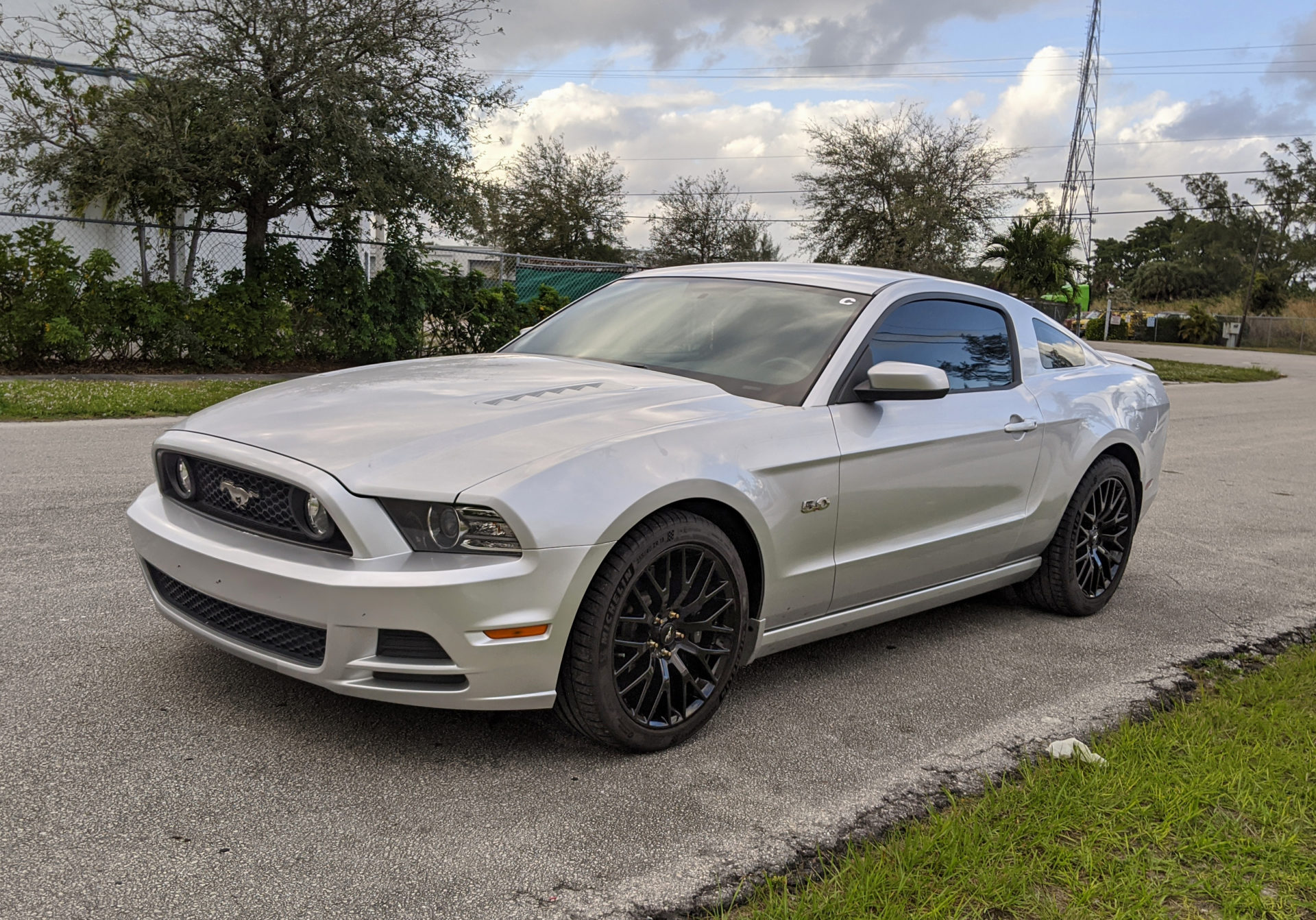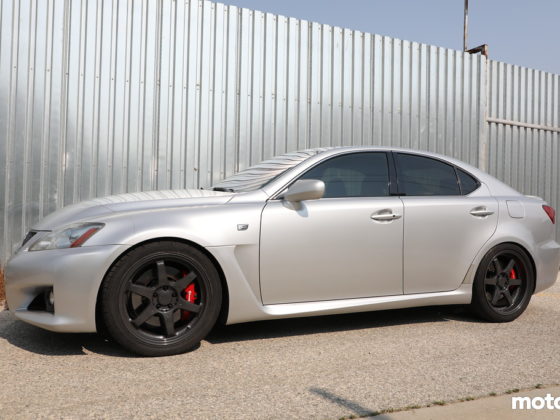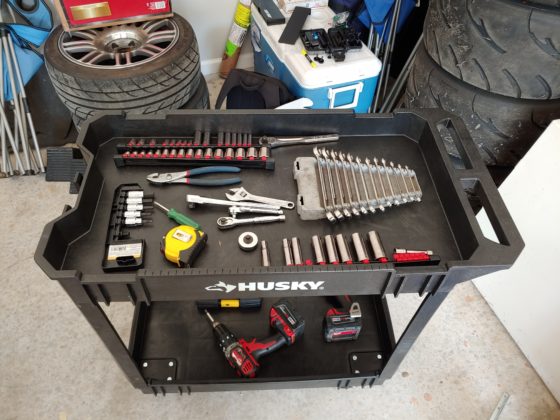
S197 Mustang GTs aren’t featherweights, but it’s not hard to get weight out of them. More importantly, you can stuff massive tires under the fenders to give it a far better tire size to weight ratio than an M3 is capable of. Choosing the right size and compound will ensure long sessions without overheating or prematurely wearing out the tires on track.
Before you bring up the C5 Z06, they are currently about $5K more than the 2011+ Coyote-powered Mustang, and both the Z06 and 5th generation Camaro fall into the same independent suspension alignment setup complexity disadvantage. Additionally, it is more expensive to make 400whp from a Z06 and a lot more to make the Camaro’s platform handle well, as it’s just not as good as the Mustang’s to begin with. The 6th Gen Camaro is a significant improvement over the Gen-5, and I like it a lot, but its price is much higher and outside the scope of these track car comparisons.

The misconception that Mustangs don’t handle well on road courses is still pretty strong despite the S197’s impressive 15 years of success in showroom stock racing.
HISTORY
Over the course of the S197’s lifespan from 2005-2014, there were a few notable changes to the drivetrain and bodywork, but the chassis remained essentially the same. 2011 brought about the introduction of far better and more desirable V8 and V6 engines. You really can’t go wrong picking an engine, except I would not consider the 2005-2010 V6.

When it debuted in 2005, the all-new S197 Mustang was a game-changer and would be the swansong of the solid axle era before an independent suspension was introduced on the S550 platform in 2015.

This chassis was extremely rigid with a torsional stiffness of 21,000 Nm/degree. This was a substantial improvement over the previous SN95 chassis which was effectively the end result of a 27-year-old chassis and suspension layout design that originated in the 1978 Foxbody Mustang.
By comparison:
4,881 Nm/deg – NA Mazda Miata
7,100 Nm/deg – Honda S2000
9,100 Nm/deg – Chevrolet C5 Corvette
12,500 Nm/deg – BMW E46 Coupe
14,500 Nm/deg – Chevrolet C7 Corvette
22,500 Nm/deg – BMW E90
23,000 Nm/deg – Ferrari 360 Modena




24 comments
looking forward to hearing why a panhard bar is better than a watts link. other than cost that is.
The S197 panhard bar’s lateral displacement under suspension movement is less than that caused by the tire carcass deformation under cornering load, especially if you’re using rod ends on the bar. A Watts link really isn’t necessary unless you want to adjust roll center, which can also be done with a weld-in adjustable panhard bar. The panhard bar is also lighter and simpler.
Idk, when I had my S197 the rear would always get thrown sideways a little going over bumps and stuff, even just driving straight. Not enough to upset the chassis or anything, but enough that I would feel it. That’s the one downside of the car. My understanding is that this doesn’t happen with a watts link since the axle moves straight up and down?
Of all the cars I’ve owed, the S197 with the 5.0 was hands down the most fun, I miss that car…
The S197 panhard bar is long enough that the arc I scribes under normal suspension movement only displaces laterally by about half an inch in either direction, which isn’t really enough to notice.
Rather, that squirrelly butt wiggle known to S197 drivers that occurs over bumps and pavement swells is mainly caused by the OEM bushing between the UCA and the axle, which is about as solid as a damp marshmallow. Replacing that bushing with some good polyurethane or–preferrably–a good spherical bearing eliminates all most all of that wiggling. That part is often overlooked on builds, though.
you may be on to something there… I ended up selling the car before I got to upgraded the UPC
Correct that the lateral displacement of the axle is insignificant and not noticeable, especially in a roll condition. The ‘wiggle’ is due to shot bushings and a lack of suspension damping. I agree that the 3rd link UCA should be upgraded, but I don’t agree with your recommendation. Stay tuned for the future articles to find out more.
Well my bushings weren’t shot, I bought the car new and did all the suspension mods (ST coilovers, BMR LCA and relocation brackets, BMR panhard bar) before it had 5k on the clock. ST isn’t the best of the best but they’re decent, I’d hope it wasn’t the coilovers causing that.
looking forward to what you do with this!
I had all the arms and bushings changed to uniball, also upgraded to wattlink but the lift off wigle still there. Didnt realy care cos wasnt upseting the car to much but I felt it.
Hey Billy, great teaser article. Can’t wait for the rest of this series. Glad to see your name at the top of the page again. The wreck at Road America looked pretty gnarly, hope you’re ok.
Thank you for asking, I am doing well. I’m glad to hear the interest in this project!
My solid axle has negative camber and toe in. All it takes is a rosebud.
This is a very compelling article and points out that there is more fun to be had than with a Miata with a Mustang!
Interesting, a Porsche 991’s stiffness in torsion is 40000 nm/deg
With as smooth as most modern race tracks are, I feel like a lot of the live axle downsides aren’t as significant as they are on the street. They sure as hell work for Trans Am!
How fancy are you anticipating going? I mean there’s fun stuff like the cambered floating axle ends with ball drive…
This is meant to be a “Budget” build, covering the bare minimum it would take to make an S197 Mustang into a competent track car where someone can beat on, have fun, and work on their driving without being limited by fundamental handling problems.
We will cover what must and should be upgraded, as well as what to do when the budget allows and/or when parts wear out. There are far too much advise out there (by people who sell parts) that they “NEED” this (unnecessary & expensive) part in order to track their car. S197’s don’t need much and that’s the focus of this project.
We will do a lot more than just the bare minimum, but this isn’t going to be a crazy build with cambered axles.
Reasonable; yeah for an 8/10ths budget build I don’t imagine it would need all that much. Will be interested in seeing where you go with it in detail. I’m just down a weird rathole of design for an SCCA GT-3 car so I have trick live axle stuff on the brain lately. 😉
I’m so excited and looking forward to these articles, such a great topic, and it’s a shame it’s going to be drawn out over time!
Looking forward to this build, too. I believe that nearly any vehicle can be made to be fun to drive on course. That said, although nearly any short coming can be addressed with enough time, skill and/or money, there are things in a build like this that are just “it is what it is.” For example, I doubt in a budget build that you are going to replace the factory pedals with aftermarket upgrades. So, that begs the question: what is your take on the things on the S197 that cannot be corrected (in a budget build), like pedal placement, seat height, steering wheel positioning, etc.? Basically, I would like to know how far Ford went with making these vehicles driver’s cars and what corrections, if any, you would/will make in a budget build. Thanks.
You can always adjust the seat height with an aftermarket racing seat, and steering position with aftermarket wheels and spacers.
This is awesome, just what I’ve been looking for! I’m on my 4th S197, love this car for all the reasons you state plus tall guys fit in it! My 07 has a 2.3 whipple, big brakes, adjustable springs and dampers, adjustable strut mounts, all heim joint rear suspension, lowered LCA mounts, upper and lower front braces, etc. However the rear suspension is way too stiff, even jarring sometimes. So your comments about too- big sway bars hits home, I’m looking forward to reading how to rein the rear suspension in.
Driving my wife’s 911 (01 C4 cab) is a great contrast to the Mustang. It’s bone stock, not a lot of power but rides like butter and frankly I don’t know where the limit is on that car – not mine, don’t want to ditch it but I do put it through the paces and it holds the road like its on rails. Just such a different car, hard to compare them. But I guarantee my Mustang will slam that Porsche in almost any contest, especially bang for $.
Will you be talking about spring rates? Ride height? I’m wondering if that’s part of my issue – too low, maybe too much spring?
Be sure to stay tuned for future articles where we go over the suspension and address some of the issues you are having. Hopefully you’ll get some insight on what to change to make the car more compliant, driveable, add rear grip, add confidence, and make it a faster car!
We will discuss spring rates, ride height, rake, and other information in upcoming articles. Stay tuned!
I’m dying to see more now!!! i have 2 race miata’s and a thunder roadster. I love them but I NEED more power. I am about to purchase a 08 gt with a kenne bell supercharger, steeda upgrade suspension and coilovers. any thoughts? its stripped inside but still streetable.
Like to compare it to a turbo in my 99 miata at 230 whp.
Thanks!
Superchargers put A LOT of heat into the engine’s coolant and oil. It will be quite a challenge and costly to keep those systems in check. If the car is stripped out and built as a track car, I would look at the experience of the owner and their lap times, and really dig into what temps the car runs at after a 20-30 minute session on a hot day.
I would caution that it’s possible that you may be more experienced and faster than he is, and run into heat issues that he hasn’t experienced.
Our goal is to make 400 WHP naturally aspirated out of the 5.0L Coyote. That’s a lot of power for a track car and it will create nowhere near as much heat as that Supercharged ’08.
“You really can’t go wrong picking an engine, except I would not consider the 2005-2010 V6.”
Can’t go wrong, so why not choose the V6?
Seriously. How about a budget build where you choose the “unwanted” engine instead?
So tired of these articles that say “It doesn’t matter what you pick…but it does.”